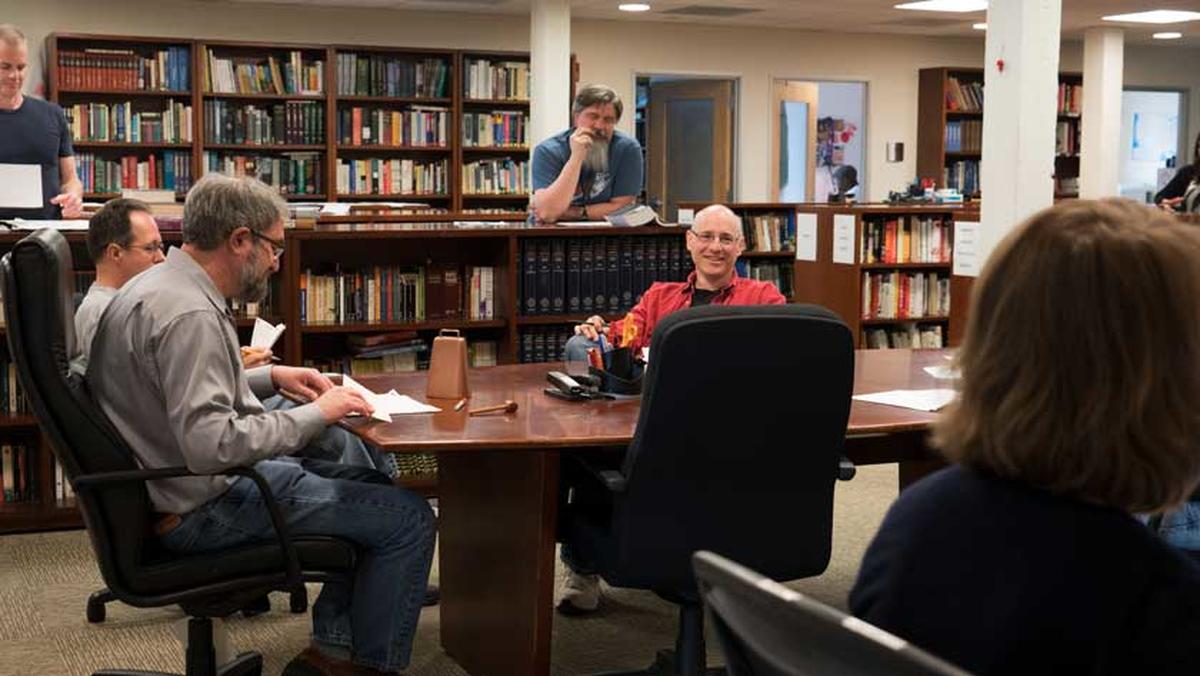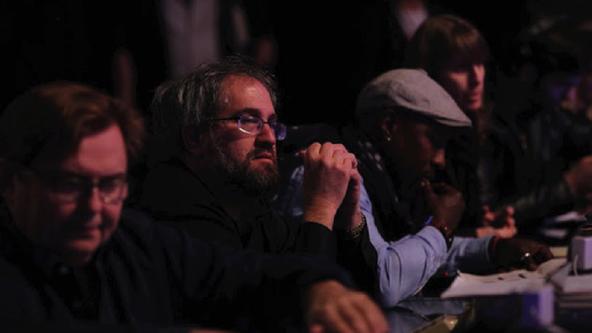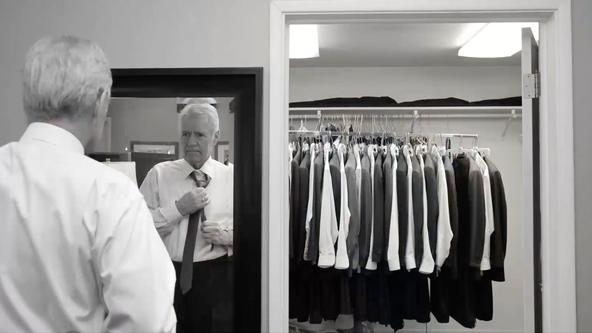Featured J!Buzz
Imagine you’re a Jeopardy! writer: Your daily assignment is to create two to three categories, each complete with five approved clues. Where do you begin? Jeopardy! head writer Billy Wisse and writer Michele Loud answer the question, as they reveal the step-by-step process the writers use to create the games every day. Not only will you learn what it takes to be a Jeopardy! writer, but you’ll also understand why the writers will never experience the sound of a cowbell the same way again.
1. IDEA GENERATION
Getting inspired to write one category is easy, but writing two each day, 52 weeks a year? A Jeopardy! writer needs a system. “For me, there are two basic ways,” Billy says. As an example, Billy points to a category written by Jeopardy! writer Robert McClenaghan, playfully named UNIVERSAL PICTURES. “You either come up with a cute title, like UNIVERSAL PICTURES, and try to find something to fit that category; or you say, ‘I haven’t written ART in a while, I’ll see if I can think of a new angle,” Billy says. ”For me, it either comes from the title or the subject.”
Sometimes, instead of starting with the category, writers may reverse the process. Michele mentions having a fact or clue she might want to use, and then coming up with the category around it.
Then, of course, there’s good old-fashioned inspiration. Michele recalls coming up with this clue while driving her car: “‘Apollo 13’ was coming out, and there was a Whitney Houston song playing on the radio when I saw the poster,” she says. “I said to myself in my car, ‘Whitney Houston, we have a problem.’ And I wrote it into a BEFORE & AFTER [category] the next day.”
2.REWRITES
Completed categories in hand, the writers hand them over to Billy for approval. It’s essentially a high-level review. “At this point, I’m checking to see if I think the clues are too difficult, or taste-wise not right for our show – or if I think we’ve done that subject too often,” Billy says.
After Billy organizes the clues from easiest to hardest (or, lowest dollar value on the board to highest), the categories move on to the researchers. A member of that team first double-sources each fact with reputable sources – usually an encyclopedia, dictionary or other appropriate resource material. If the clue passes that test, the researcher then tries to come up with any possible alternative responses to the clue; if unable to come up with one, the researcher can consider this clue “pinned.” If clues do not pass these double-sourcing or pinning tests, the writers will rework them as necessary until they get approval from the research team.
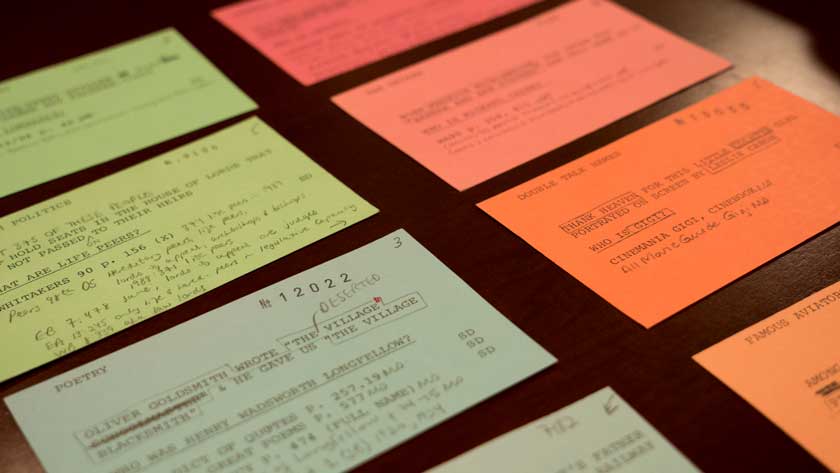
Vintage category note cards from the early days of the show. The Jeopardy! head writer has always used colors to plan a variety of categories for each game, though the system has since gone digital. Orange is the one color no longer in use.
3. BALANCE THE GAMEBOARD!
Jeopardy! is designed for a large audience to play along, and the categories for each game reflect that. “The board needs to be balanced,” Billy says, noting the color-coded topics he uses for planning out gameboards. “You have to have a good mix of academic subjects (blue), pop culture (pink), wordplay (yellow) and some that are more lifestyle (green), like a potpourri – or miscellaneous – category.”
If a board feels unbalanced, Billy will reach out and ask the writers to fill a specific need. “For example,” says Michele, “Billy is good about telling the writers, ‘I’m really running low on geography.’”
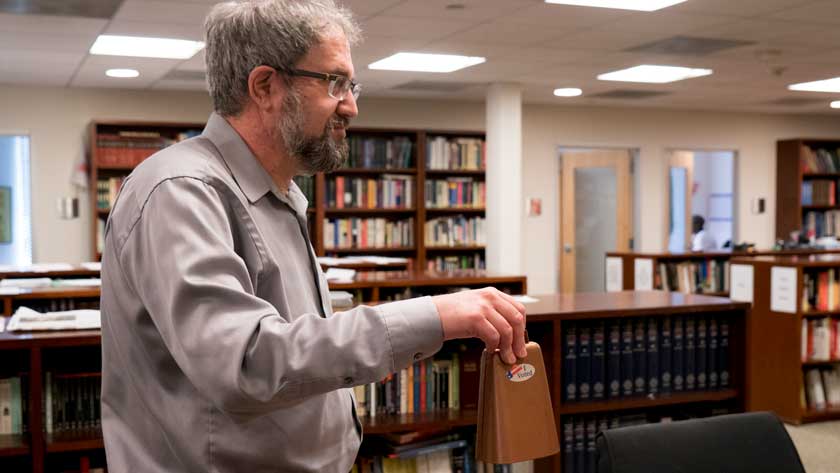
The writers know it’s time for the roundtable to start when they hear the ring of Billy’s cowbell.
4. THE ROUNDTABLE MEETING
Each season, the writers produce a total of 230 games; that comes out to 14,030 clues per season. To maintain the Jeopardy! standard for these games, the writers periodically get together to discuss the material and identify any potential issues. This meeting is called “the roundtable.”
When multiple games are ready for the roundtable, Billy rings the bell … the cowbell. The writers assemble at the roundtable, prepared to scrutinize clues for clarity and difficulty. “We do not want to stump the contestants,” says Michele. “That’s a boring game, and it’s bad television. So it’s much more satisfying to have someone give the correct response to a clue.”
Since there is a limit to the number of characters and lines in each clue, the writers will occasionally propose slight rewording to take up less space. They may also point out that certain clues have multiple correct responses and suggest ways to pin the clue. Some of these suggestions meet little resistance from the category’s writer; others spark fierce debate.
After going through each category for the game, writers identify candidates for Daily Doubles. The main guideline for a Daily Double is that contestants will often have to complete a two-step process to get to the correct response.
The same Daily Double requirement also applies to Final Jeopardy! clues. As an example from today’s game, maybe you didn’t know that William Goldman wrote a story for his daughters based on two words they said. But you might remember his most famous books containing two nouns. Between “Father’s Day,” “Marathon Man” and “The Princess Bride,” you’d probably want to pick the last choice, which would lead you to the correct response.
As for level of difficulty for Daily Doubles, that depends on the dollar amount of the clue, but sometimes one word makes all the difference. “A too-easy clue can be made more difficult by simply removing a word,” says Billy. “Conversely, a too-difficult clue can be made easier by adding a word.”
5. MORE REVISIONS
Leaving the roundtable meeting, writers have yet another round of changes to make to their categories based on the suggestions from their fellow writers. Once they’ve made their revisions and the researchers have approved the clues, their work is done … until tape day, that is. At that point, they have a whole new set of responsibilities.
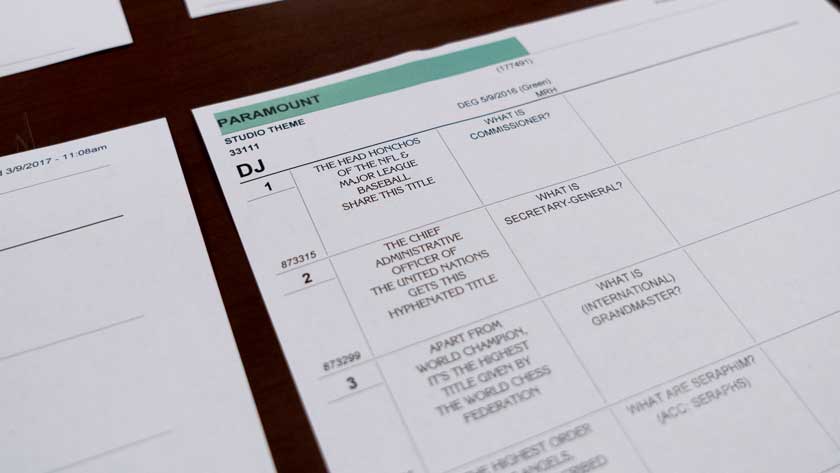
One category from today’s MOVIE STUDIOS theme board.
WHAT ABOUT THEME BOARDS?
On today’s show, you may have noticed a MOVIE STUDIOS theme running across every category in the Double Jeopardy! round. If you’ve ever wondered how theme boards like this come about, there’s no hard and fast rule, but this one began with an astronomy category from Jeopardy! writer Robert McClenaghan.
While writing his daily categories, Robert noticed one standing out from the rest. It was a category written around pictures captured by the Hubble Space Telescope, which he called UNIVERSAL PICTURES. Seeing its potential as part of a larger theme, Robert took the idea to Billy, and the MOVIE STUDIOS gameboard came together as follows:
MOVIE STUDIOS (pop culture)
COLUMBIA (academic)
PARAMOUNT (miscellaneous)
WARNER BROS (miscellaneous)
UNIVERSAL PICTURES (academic)
“M_G_M” (wordplay)
With the categories locked in, Robert invited other writers to “play along,” and each one came up with clues for a category. After that, the process for this theme board was the same as for any gameboard.
From pitching theme board ideas to fulfilling category requests from Billy, the Jeopardy! writers do it all with aplomb, and that’s no accident. “We come in and do this year-round,” says Michele. “You have to keep writing categories and keep doing the same thing every day. Not just grind it out, but be consistent with your productivity; be inspired and fresh and fun.” Bottom line: These folks love what they do.


